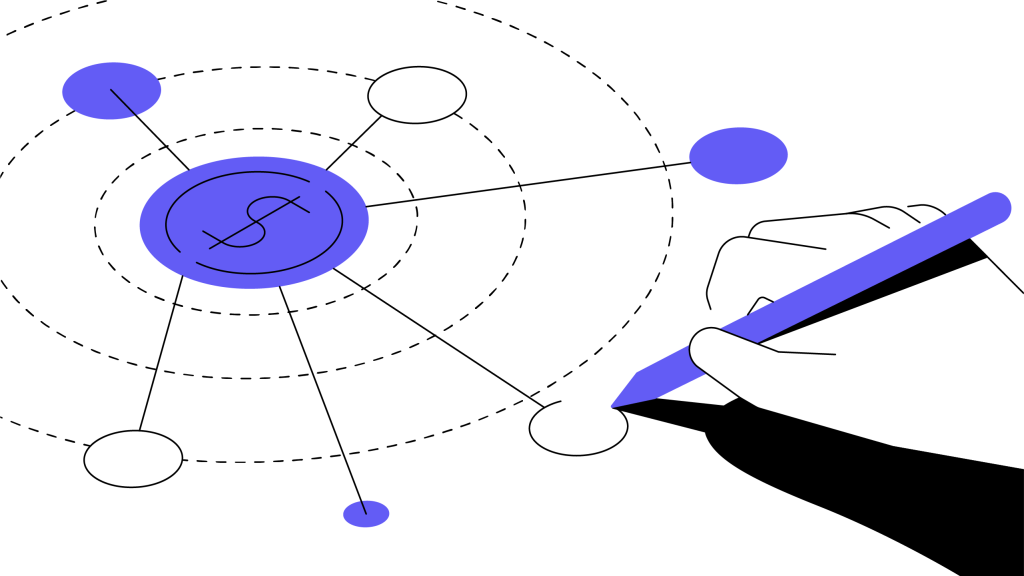Contents
What Is USDC? How Does It Work?
What is USDC? Learn how this stablecoin works, why it’s trusted, and how to use it for trading, payments, DeFi, and digital asset storage.

Summary
Cryptocurrency is known for its volatility, but not every token rides the roller coaster. USD Coin (USDC) is designed for stability. Pegged 1:1 to the U.S. dollar and backed by reserves subject to monthly attestations by an independent accounting firm, the USDC stablecoin gives users a predictable, secure way to engage with the crypto economy. Whether you're sending money globally, exploring DeFi, or storing digital value, USDC offers the reliability of fiat with the flexibility of blockchain.
What Is USDC?
USD Coin (USDC) is a stablecoin designed to maintain a constant value of $1 USD.
Created by the Centre Consortium — a partnership between Coinbase and financial technology firm Circle — that bridges the gap between traditional fiat money and blockchain-based finance. As a fiat-backed stablecoin, each USDC is pegged to the U.S. dollar, offering stability and trust in a notoriously volatile crypto landscape.
Unlike cryptocurrencies like Bitcoin or Ethereum, which can fluctuate wildly, USDC is designed for predictability. That makes it an ideal option for payments, decentralized finance (DeFi), and reducing risk during crypto market swings.
Gemini supports USDC, allowing users to buy, sell, and store it securely with a regulated and trusted platform.
How Does USDC Work?
is a stablecoin issued by CENTRE — a joint venture between Coinbase and Circle. The cryptocurrency is backed by U.S. dollar-denominated assets held at regulated and audited U.S. financial institutions.
Each USDC is intended to be redeemable for one U.S. dollar and is backed 1:1 with dollar reserves or dollar-denominated assets. Those accounts are audited by U.S. accounting firm Grant Thornton LLP, which issues monthly attestations on the reserves backing USDC — ensuring transparency and public trust.
Which Blockchains Support USDC?
USDC was first launched on Ethereum as an ERC-20 token, but it has since expanded to multiple blockchains, including Solana, Stellar, and Algorand. The token utilizes smart contracts to power programmable money transactions, which function at speed and minimal cost between decentralized systems.
Circle's regular reports enable users to validate that all circulating USDC tokens derive from real assets. The market recognizes USDC crypto as one of its most reliable stablecoins because Circle maintains transparency about its held assets.
What Is USDC Used For?
Since stablecoins like USDC have historically experienced lesser volatility compared to digital assets like bitcoin (BTC) or ether (ETH), they can be ideal for payments and remittances and are often favored by traders who wish to place profits made from trading in higher-volatility digital assets into more lower-volatility digital assets without exiting to fiat.
USDC serves as the foundation that supports numerous crypto ecosystem operations. Users employ USDC in the following primary ways:
Stable Trading Pairs: People leverage USDC as their stable asset to maneuver between higher-risk cryptocurrencies.
Remittances and Global Transfers: USDC supports fast cross-border payments through remittances and global transfers, which operate at low costs.
DeFi Applications: USDC functions as the main stablecoin on many DeFi applications, including Aave and Compound, where users can borrow money, provide liquidity, and participate in lending operations.
Payment Systems: USDC has become acceptable for online payment methods through merchant adoption, which shortens payment durations.
Capital Preservation: Investors use USDC to hold their profits, protecting their funds from the cryptocurrency market's price fluctuations.
between traditional banking systems and digital assets, boosting the accessibility of digital currencies.
USDC vs. Other Stablecoins
Various stablecoins have proliferated as the crypto ecosystem has developed, and many are now an essential part of the market. How a stablecoin maintains its stability — known as its peg — is dependent on its infrastructure.
USDC vs. USDT
While both are fiat-backed, USDC is widely considered more transparent due to its regular audits and U.S.-based oversight. Tether has faced criticism over opaque reserve disclosures.
USDC vs. Algorithmic Stablecoins
USDC is backed by real-world assets, whereas algorithmic stablecoins attempt to maintain their peg through supply and demand mechanisms, which have proven unstable in extreme cases.
USDC vs. BUSD
Binance USD is another regulated fiat-backed coin, but USDC's multi-platform reach and issuance through Circle give it broader adoption.
Who Created USDC?
The USDC stablecoin was created by CENTRE, an organization founded by crypto exchange Coinbase and financial technology (FinTech) firm Circle.
This U.S.-based consortium of two companies created the Centre to develop a stablecoin solution using for global crypto adoption. USDC gained market trust because of the combined authority, regulatory support, and transparency commitment from the provider organizations.
Circle invests in regulatory collaboration with financial supervisors to foster both the safe utilization of stablecoins and the development of blockchain-based finance networks as a part of conventional systems.
Is USDC Regulated?
USDC’s credibility is built on transparency and compliance. Its issuer, , works with U.S. and global regulators to meet high standards.
U.S. Oversight
USDC complies with proposed regulations like the Stablecoin TRUST Act, meeting requirements such as full-reserve backing and regular audits.
Global Frameworks
Regions like the EU and Singapore are also introducing that align with USDC’s model of transparency and sound financial practices.
Why It Matters
By prioritizing regulatory alignment and public disclosures, USDC earns trust from users, businesses, and institutions alike.
Unlock the future of money on Gemini
Start your crypto journey in minutes on the trusted crypto-native finance platform
Is USDC Safe?
because it maintains dollar-reserved assets that undergo regular audits while sticking to U.S. regulatory requirements.
The token is backed by U.S. dollar-denominated assets held at regulated and audited U.S. financial institutions. This backing is verified monthly through attestations, ensuring that each token is always redeemable for one U.S. dollar.
While USDC is designed to be stable and backed by reserves, it is still subject to certain risks.
Use Secure Wallets
Cold wallets (offline storage solutions) offer offline protection from the internet, thereby securing private keys from attacks.
Enable 2FA
Implementing two-factor authentication (2FA) provides increased defense against unauthorized access to your crypto account assets. If someone manages to obtain your password, they will still need a second account verification process utilizing a mobile code to enter your account successfully.
Choose Trusted Platforms
When dealing with USDC exchanges, users must select regulated exchanges like Gemini, which provide secure storage facilities. The platforms implement top encryption methods combined with secure custody functions and regulatory monitoring systems to defend user account funds.
These security measures increase your USDC protection level despite having robust regulatory systems.
How To Buy USDC on Gemini
Gemini has maintained its commitment to establishing connections between conventional finance and blockchain domains through its support of USDC.
Gemini is a New York trust company with NYDFS regulatory authorization to deliver secure and compliant USDC storage and trading options. Gemini offers operational security and transparency to provide users with peace of mind when they utilize USDC to transact, store value, or access DeFi resources.
Gemini users obtain enhanced security because the exchange operates on a full-reserve basis that ensures all customer assets remain accessible and prevents any loaning arrangements. Keeping your USDC at Gemini gives you access to a stablecoin secured both by dollars and through Gemini’s record of regulatory compliance leadership.
Buying USDC on Gemini is quick and secure. Here’s how:
Create a Gemini Account: Sign up and complete identity verification.
Deposit Funds: Add money via bank transfer, wire, or crypto deposit.
Buy USDC: Navigate to the USDC page and place your order.
Secure Your Funds: Leave them in your Gemini wallet or transfer them to an external wallet for added security.
Gemini’s strong security, user-friendly interface, and global compliance make it an ideal platform for purchasing and managing USDC holdings.
Why USDC Stands Out
The secure, transparent stablecoin USDC uses fractional reserves of U.S. dollars to provide predictability to the decentralized financial system. USDC maintains its $1 peg courtesy of audited real-world assets issued by respected U.S. financial institutions during monthly audits.
USDC provides users with a dependable means to participate in the digital financial system through its capabilities for trading, storing value, DeFi exploration, and quick cross-border payments.
Sign up on and start trading today.

Author
Is this article helpful?
